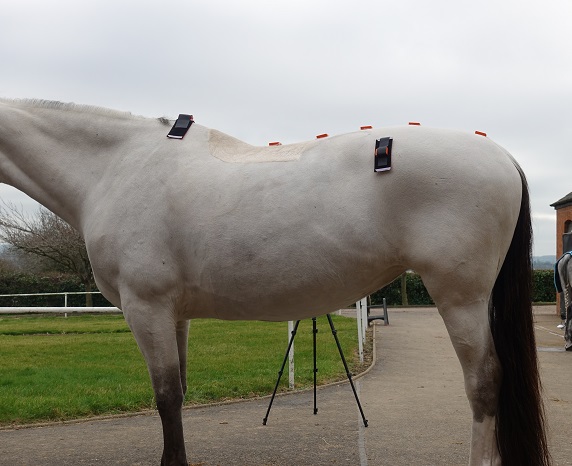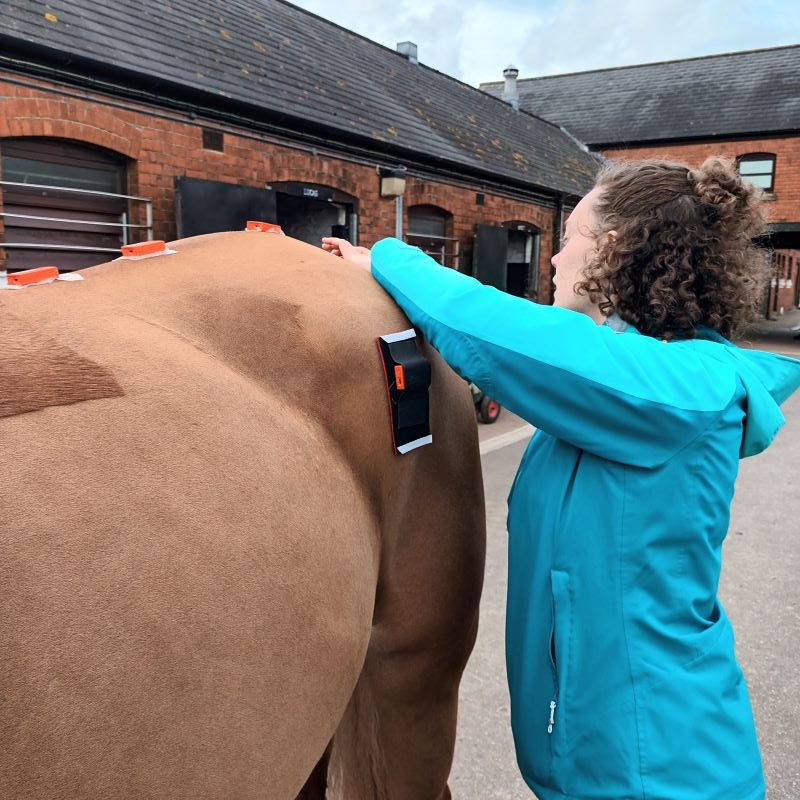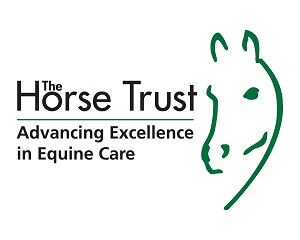
Back movement in the horse: what is normal in relation to age, breed and use?
This study aims to provide fundamental data on the association between equine movement asymmetry and back movement in relation to age, breed and use.

Which horse groups are being studied?
- Military horses (Kings Troop/Household Cavalry/Horse Trust)
- Thoroughbred racehorses
- Sports horses (dressage horses, show jumpers, eventers)
Both active and retired horses are being assessed
Who can participate in this study?
We are particularly keen to recruit sports horses (either active OR retired) who are based in the London/South East area (ideally within a 50-mile radius of Potters Bar in Hertfordshire)
Challenge
Lameness and back disorders often co-exist in horses1. Although the advent of mobile and practical assessment techniques has expanded our understanding about lameness and movement asymmetry considerably2–4, the same cannot be said about back movement. Until recently5–9, no practically relevant techniques were available that allowed simultaneous quantitative assessment of asymmetry and back range of motion (ROM). However, knowledge about how back movement is influenced by movement asymmetry10–12 is crucial for addressing questions about the origin and interrelation of the two and for quantifying the importance of influencing factors; such as age, breed, and use. These factors appear relevant based on practical and scientific experience: first, older retired horses and lame horses present with a ‘stiff/stilted’ gait13,14; second, there are differences in back motion between horses of different breeds15; and third, ex-racehorses undergoing a phase of ‘retraining’ require a period of adaptation to new activities, with subjective increases in back movement.
Solution
In this project, we are collecting simultaneous back movement and gait symmetry data together with epaxial muscle dimensions of the thoraco-lumbo-sacral area in specific groups of horses. Each group will consist of a mixture of ‘active’ and ‘retired’ horses. Interestingly, these groups experience very different biomechanical conditions during their active life: carrying heavy loads/pulling heavy equipment, performing advanced show jumping and dressage manoeuvres or maximum speed running. They also encounter different surfaces. We expect this to result in different back movement dynamics combined with breed and use specific differences in back dimensions.
What research questions are being addressed?
Is there a relationship between movement asymmetry and back ROM with increasing asymmetry resulting in a reduced ROM (i.e. a stiffer back)?
Is there a relationship between age, breed, use and back dimensions and back ROM? For example, will increasing age and/or reduced exercise result in a reduced ROM and decreased epaxial musculature dimensions?
Do different groups of horses show different associations between movement asymmetry and back ROM. For example, is back ROM in older, retired horses less affected by movement asymmetry due to their generally ‘stiffer’ gait?
After retirement from their discipline, do gait parameters and back measurements undergo change? For example, will racehorses, undergoing a ‘retraining scheme’, develop more dynamic back motion? In future, these data can then be compared to alternative retraining and rehabilitation regimens.

How will the research be conducted?
The horse will be studied during:
Straight line walk + trot on hard + soft surface
Circle exercise on left/right rein in walk + trot on soft surface
Nine inertial sensors will be fitted to poll, withers, thoracic area, lumbar area, tuber coxae and caudal sacrum (with double-sided tape) to assess the horse’s gait. We will also use a Flexi-curve ruler, tape measure and height stick to measure back and limb dimensions.
How long does this process take?
Typically, a session will be 30–40 minutes (including setting up the analysis equipment)
It is a one-time assessment only
Where does the research take place?
If your yard/stable is situated within a 50 mile radius of Potters Bar (Hertfordshire) we will arrange to come and conduct the research there. Horses located further afield will be considered on a case-by-case basis (and ideally, we would like to study more than one horse in a single appointment).
When is the study being conducted?
We are conducting the research in Spring/Summer 2023, so we would like people to apply by 31st May
Is participation anonymous?
Yes. If you wish to be informed directly about the final outcomes of the study, our research team can send you an update by email.
Why is this study significant?
Locomotor disorders impede the lives of many horses across all stages of lives and across different uses. In this research project, we are aiming to implement a quantum leap in the understanding between lameness and back problems.
We will generate practically relevant information about how age, breed and use influence back movement parameters and provide a set of guideline values describing back movement as a factor of age, breed and use. We envisage this will be essential for improving the detection of back related disorders and diagnosing their origin. Early detection appears to be of particular relevance for optimising musculoskeletal health and thus maximising the active life of horses in different disciplines. It is also important to better understand back movement patterns in older horses, retired from ‘active work’, to be able to develop custom rehabilitation regimens for specific horse groups.
Who will find the study findings useful?
The results will be relevant to equine clinicians, farriers, physiotherapists and other equine paraprofessionals, owners and sports/working horse associations.
This study is funded by the Horse Trust
Need more information about this project?
Please contact Kate Horan, Postdoctoral Research Assistant, RVC Structure & Motion Laboratory khoran@rvc.ac.uk
Partners
Professor Thilo Pfau, Visiting Associate Professor at RVC & Professor in the Departments of Kinesiology and Veterinary Medicine, University of Calgary
Dr Russell Mackechnie-Guire, Centaur Biomechanics
Major Harriot Telfer, Royal Army Veterinary Corps
Dr Rebecca Parkes, City University Hong Kong
References
- Landman MAAM, de Blaauw JA, van Weeren PR, Hofland LJ. Field study of the prevalence of lameness in horses with back problems. Vet Rec. 2004;155(6):165-168. doi:10.1136/vr.155.6.165
- Keegan KG. Evidence-Based Lameness Detection and Quantification. 2007;23:403-423. doi:10.1016/j.cveq.2007.04.008
- Reed SK, Kramer J, Thombs L, Pitts JB, Wilson DA, Keegan KG. Comparison of results for body-mounted inertial sensor assessment with final lameness determination in 1,224 equids. J Am Vet Med Assoc. 2020;256(5):590-599.
- Pfau T. Sensor-based equine gait analysis: more than meets the eye? UK-Vet Equine. 2019;3(3):102-112. doi:10.12968/ukve.2019.3.3.102
- MacKechnie-Guire R, MacKechnie-Guire E, Fairfax V, Fisher M, Hargreaves S, Pfau T. The Effect That Induced Rider Asymmetry Has on Equine Locomotion and the Range of Motion of the Thoracolumbar Spine When Ridden in Rising Trot. J Equine Vet Sci. 2020;88:102946. doi:10.1016/j.jevs.2020.102946
- Martin P, Cheze L, Pourcelot P, Desquilbet L, Duray L, Chateau H. Effect of the rider position during rising trot on the horse’s biomechanics (back and trunk kinematics and pressure under the saddle). J Biomech. 2016;49(7):1027-1033. doi:10.1016/j.jbiomech.2016.02.016
- Martin P, Cheze L, Pourcelot P, Desquilbet L, Duray L, Chateau H. Effects of the rider on the kinematics of the equine spine under the saddle during the trot using inertial measurement units: Methodological study and preliminary results. Vet J. 2017;221:6-10. doi:10.1016/j.tvjl.2016.12.018
- Pfau T, Simons V, Rombach N, Stubbs N, Weller R. Effect of a 4-week elastic resistance band training regimen on back kinematics in horses trotting in-hand and on the lunge. Equine Vet J. 2017;49(6):829-835. doi:10.1111/evj.12690
- MacKechnie-Guire R, MacKechnie-Guire E, Fairfax V, Fisher D, Fisher M, Pfau T. The Effect of Tree Width on Thoracolumbar and Limb Kinematics, Saddle Pressure Distribution, and Thoracolumbar Dimensions in Sports Horses in Trot and Canter. Animals. 2019;9(842):1-22.
- Greve L, Dyson S, Pfau T. Alterations in thoracolumbosacral movement when pain causing lameness has been improved by diagnostic analgesia. Vet J. 2017;224:55-63. doi:10.1016/j.tvjl.2017.03.009
- Gómez Álvarez CB, Wennerstrand J, Bobbert MF, et al. The effect of induced forelimb lameness on thoracolumbar kinematics during treadmill locomotion. Equine Vet J. 2007;39(3):197-201. doi:10.2746/042516407X173668
- Gómez Álvarez CB, Bobbert MF, Lamers L, Johnston C, Back W, Van Weeren PR. The effect of induced hindlimb lameness on thoracolumbar kinematics during treadmill locomotion. Equine Vet J. 2008;40(2):147-152. doi:10.2746/042516408X250184
- Dyson S, Greve L. Subjective Gait Assessment of 57 Sports Horses in Normal Work: A Comparison of the Response to Flexion Tests, Movement in Hand, on the Lunge, and Ridden. J Equine Vet Sci. 2016;38:1-7. doi:10.1016/j.jevs.2015.12.012
- Greve L, Dyson S. Saddle fit and management: An investigation of the association with equine thoracolumbar asymmetries, horse and rider health. Equine Vet J. 2015;47:415-421. doi:10.1111/evj.12304
- Heim C, Pfau T, Gerber V, et al. Determination of vertebral range of motion using inertial measurement units in 27 Franches-Montagnes stallions and comparison between conditions and with a mixed population. Equine Vet J. 2016;48(4):509-516. doi:10.1111/evj.12455

